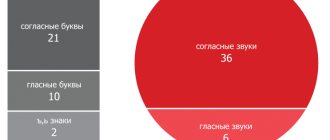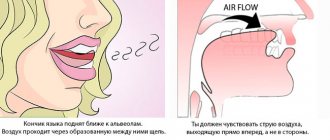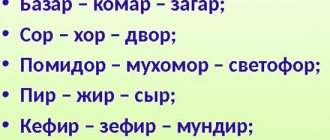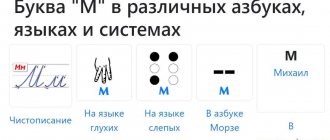A set of articulation exercises
The exercise includes 5 exercises and can also be done at home.
“Horse” - clicking the tongue. This is a very useful and effective exercise. Not all children get it right away.
“Pancakes” - the baby opens his mouth slightly, spreads his tongue into a flat pancake.
“Snake” - the child imitates the sting of a snake - the tongue is just as sharp. Then he sticks it back and forth.
“Tube” - the baby tries to roll his tongue into a tube.
Another exercise is to try to reach the tip of your tongue to your nose and then to your chin.
Stages of correction of sound pronunciation disorders
The speech therapist adheres to a strict sequence of sound production for dysarthria. Corrective work consists of 6 stages.
First: the specialist prepares the articulatory base for the production and pronunciation of palatal, sonorant, hissing and whistling sounds. When the baby masters some of them, the speech therapist moves on to working on them. It involves kinesthetic, auditory and visual control. Here is an example of a speech therapist’s instructions to a small patient: “Look in the mirror and repeat after me,” “Look in the mirror and do the exercise,” “Look at yourself in the mirror, stretch out your lips.” This feature of sound production gives good results.
This approach is necessary to reduce the apraxic disorders that accompany dysarthria. In general, the first stage is the foundation for the further development of sound pronunciation skills.
Second: the speech therapist determines the sequence of correction. He assesses which articulatory structure the patient has “mature”. Many children with motor and speech disorders are better at producing more complex sounds, such as hissing sounds. But the patient can master lighter whistling sounds, with which it is recommended to begin correction, later.
Third: the specialist stimulates or plays a certain sound. When staging, he uses classical techniques - staging by imitation, mechanical or mixed method.
Fourth: consolidation, or automation. This is the most difficult stage in all correctional work. It takes the most time. Often children master a sound and pronounce it in isolation, but make mistakes in speech. Therefore, after the production stage, the speech therapist focuses on working on isolated sound pronunciation, and then connects words with different syllable structures. Thus, the child pronounces the sound at the beginning, middle or end of words. Then the speech therapist connects sentences in which the sound being studied is concentrated.
The speech therapist selects lexical material individually. It must be appropriate for the baby’s age and capabilities, and also not include sounds that he cannot yet pronounce or distort.
Fifth: separation of delivered and oppositional sounds. First, the speech therapist suggests 2 syllables, then increases to 3. for example, sa - sha, sta - shta, etc. After this, he works on pairs of words with different syllable structures.
Sixth: developing communication skills. Another difficult stage. Often children communicate in a speech therapist’s office, but in front of other people and outside the office, the acquired speech skills are lost, and the child begins to speak “the old fashioned way.” In order to develop communication skills, the painstaking work of a speech therapist is necessary, but without the desire of the child himself, success cannot be achieved either.
The development of communication skills in dysarthria is facilitated by techniques such as memorizing rhymes, retelling or writing stories.
Making the sound "p"
At the first stage of treatment, the sound “p” is automated and the sound “p” is differentiated. The order of sound production depends on the degree of difficulty for pronunciation, the gradual transition from easy to pronounce to difficult to pronounce sounds. The order of sounds will depend on the similarity in articulation and acoustics. The sound “p” is labiodental, oral, plosive, stop, instantaneous, voiceless. At the moment the sound is pronounced, the lips are closed and tense, then the lips open and the air pushes out. There is a small distance between the teeth, the soft palate closes the passage to the nose, the vocal cords are open. Sound production is based on imitation, speech motor rhythms are used.
Making the sound "n"
Articulation and production of the sound “n” is carried out. During articulation, the lips are in a neutral position, the tip of the tongue touches the upper teeth, and vibration occurs in the nasal cavity when pronouncing a sound. Sound production is carried out using two methods: imitation and from the sound “m”. Method of imitation: the child touches his nose with a finger of one hand, and the doctor’s nose with a finger of the other hand. The doctor shows the position of the tongue in the mouth while pronouncing the sound. The child feels the vibration and tries to repeat it.
Method for the sound “m”: the child’s tongue is inserted between closed lips, the child pronounces a drawn-out “m”. A hint of the sound “n” is heard. As you get used to the interlabial pronunciation of the sound “n” in words, the lips are parted with your fingers. The tongue is then moved to its normal position towards the upper teeth.
Setting the sound "sh"
Setting the sound “ch” for dysarthria and the sound “sh”, “d”, “zh”, “sch”, “ts”, “g”, “b”, “r”, as well as setting the sound “z” for dysarthria carried out in the second stage. Methods for making the sound “sh” for dysarthria are used after the child learns to make a cup with his tongue. The wide tongue rises to the upper teeth, preventing air from passing through the edges. The tip of the tongue forms a gap with the palate. The child should exhale warm air with some effort; vibration should not be created in the larynx. The sound “sh” can be corrected from the sound “r” and the syllable “ksh”. Sound production is carried out using a spatula or spatula, which helps slow down the vibration of the tongue and the result is hissing. Sound production can be done by imitation.
Staging hissing sounds
Training takes place through classes; methods for producing hissing sounds depend on the diagnosis and the level of psychomotor dysfunction. The principle of an individual approach is used; classes should develop the child emotionally and intellectually. During the production of sounds, visual, auditory and tactile analyzers are connected, motor-kinesthetic, auditory-visual-kinesthetic, and didactic methods are used. Active and passive articulatory gymnastics and massage are performed.
How to make the sound "r"
An experienced speech therapist knows how to make the sound “r” for dysarthria, how to make the process of automating the sound “r” interesting. Making the sound “r” with dysarthria can take a long time. After warming up, the doctor asks the child to memorize the words, then repeat them using pictures. The pictures depict objects, flowers, plants, animals whose names contain the sound “r”. Such activities train memory and correct sound pronunciation. Methods used to make the sound “r”:
- Imitation.
- Through articulation.
- Mechanical assistance: from the reference sound, from the articulatory structure.
Making the sound "th"
The sound “th” refers to the middle lingual, oral, fricative, consonant, voiced, soft sounds. Before setting the sound “th”, speech therapy gymnastics is carried out, then the sound is set by imitation, which is accompanied by tactile sensations and demonstration of articulation. Sound production can be done by pronouncing the sound combinations “ya” at a fast pace, using the sound “z”, pressing the tip of the child’s tongue when pronouncing the sound - the sound “th” is obtained. The sound “th” is heard when the sound “h” is pronounced.
Principles of speech correction for dysarthria
Speech therapists use several principles when working with children. Here they are:
- Individual approach. The specialist evaluates the compensatory capabilities of the little patient - what articulatory movements have been preserved, what sounds and syllables the baby pronounces correctly;
- From simple to complex. Correction always begins with those sounds that the child pronounces best. This sequence of sound production for dysarthria allows you to achieve better results.
- Long practice of each sound. Speech correction in children with dysarthria requires much more time than other speech therapy problems.
Corrective work includes the following stages: production, automation and differentiation of sounds. But the very first task of a speech therapist is to teach the child to distinguish them by ear.






